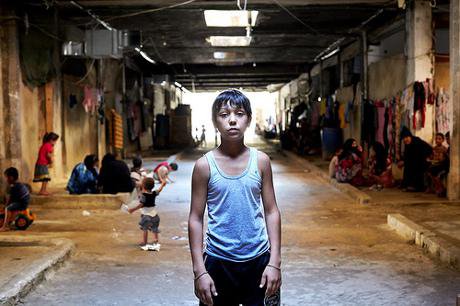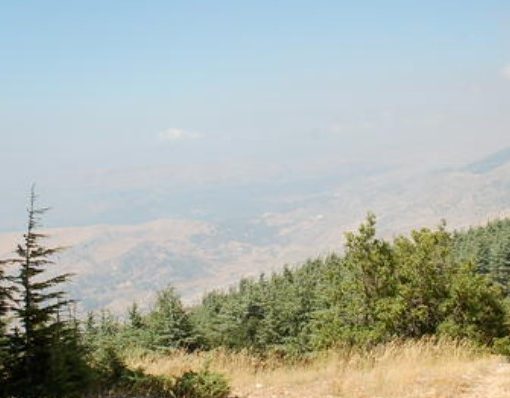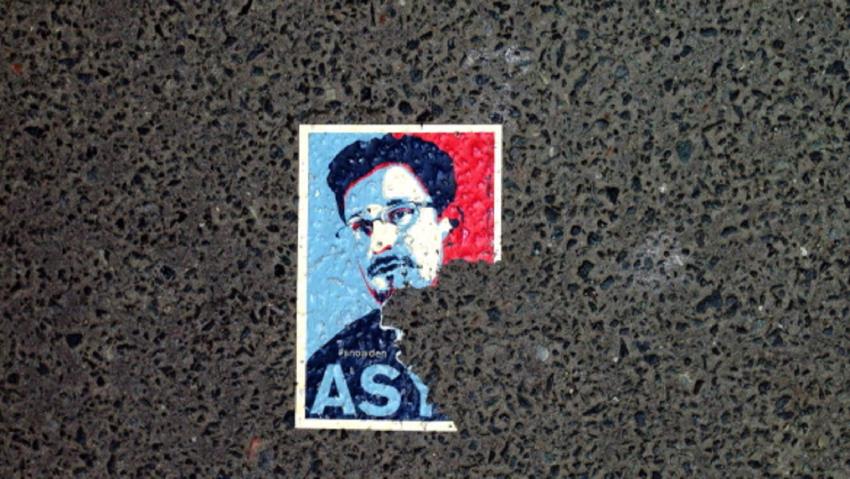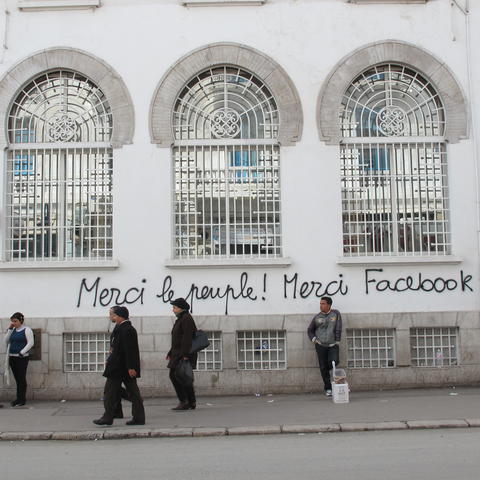I was determined that this latest crisis wouldn’t keep me out of the country of my birth.
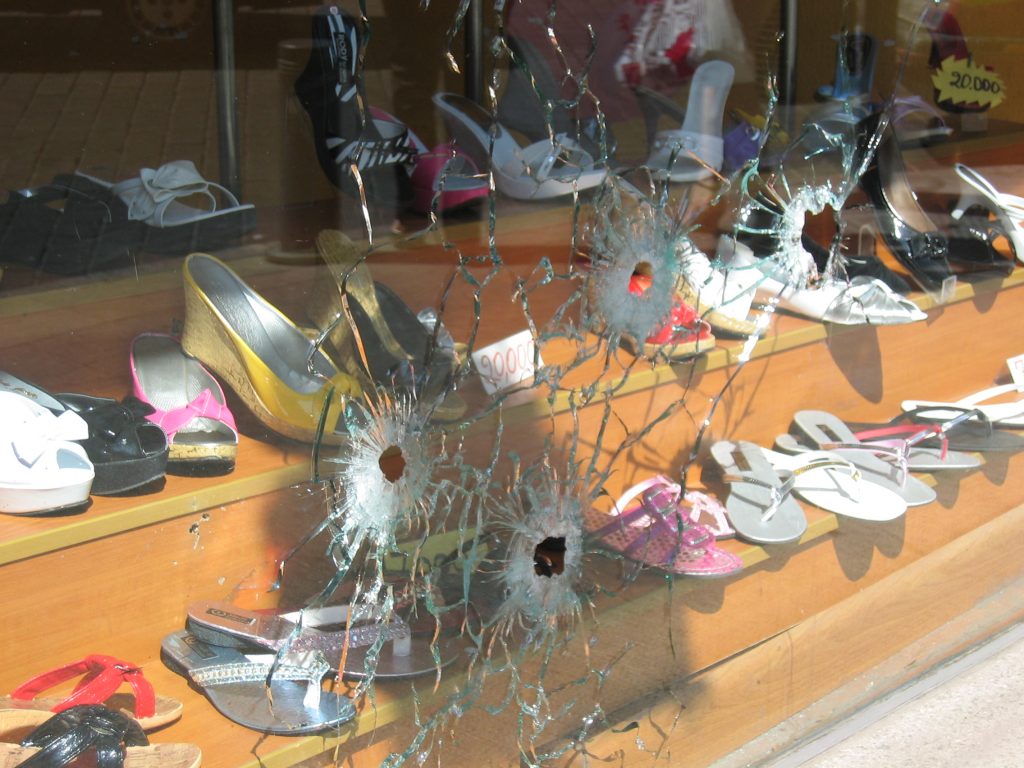
I landed in Beirut on May 21, the day of the agreement in Doha. Eighteen months of stalemate between the pro-Western government (the ‘March 14’ coalition of Sunni, Druze and Christian parties) and the opposition (the Shi’a Hezbollah and its unlikely Christian ally, Michel Aoun), during which the parliamentary vote for the President of the Republic was postponed countless times, had culminated in Hezbollah’s march into west Beirut and the Chouf mountains for two tense weeks in May.
Hamra, Beirut’s Oxford Street, had been abandoned as Hezbollah gunmen occupied the area. People hid in their houses, away from the windows, while bullets flew past in clashes between the gunmen and the March 14 militias. The country was brought closer to civil war than at any time since 1990.
I was determined that this latest crisis wouldn’t keep me out of the country of my birth. Having grown up in London because of the 1975-1990 civil war, I have spent much of my adult life making up for the absence. The Rafik Hariri airport – Lebanon’s only international airport – had been closed for a few days but reopened when Hezbollah handed its positions to the Lebanese army. As my plane took off from Heathrow, I didn’t know whether the airport would close again. But during my flight, Qatar performed its new role as regional peacemaker, and the meeting it hosted in Doha came to an unexpectedly successful conclusion. When I landed there was clearly a sense of relief. After days stuck indoors, fearing the worst, people were emerging into the streets, returning to bars and restaurants, happy but wary, disorientated by the suddenness of the agreement, trying to adjust to the idea that it was going to be a calm summer after all.
The abruptness of both the crisis and its resolution proved not only that ordinary people had little control over their destinies, but also that they were distanced from the political classes and the greater regional and international powers. Internal conflict and external interests could still undermine Lebanon as a nation state, as had been made apparent during the devastating July 2006 war between Israel and Hezbollah.
With each crisis, a wave of immigration depletes the country of its population and businesses. I spent a day working at my friend Mira’s office when the wifi connection in my building wasn’t working. Mira is an investment banker who gave up a job at Lazard in London to move back to Beirut in 2002, and now works for a Lebanese corporate finance and advisory firm. The latest events had emptied her office: her colleagues were either at the Dubai branch, where the company increasingly had more work than in Lebanon, or had resigned and left the country. I had the pick of empty desks and the two of us worked alone in the downtown prime real estate office, occasionally wandering over to the window to look at the view over Martyr’s square.
Since December 2006, opposition demonstrators had been occupying Martyr’s Square, Beirut’s symbolic heart and the centre of the late Prime Minister Rafik Hariri’s massive post-civil war reconstruction project. Doha gave Hezbollah and its allies a third of the cabinet seats (which they had wanted since Hezbollah’s ‘victory’ against Israel in 2006), a proportion that would allow them to veto any policies they don’t like (including the UN tribunal investigating Hariri’s assassination, for which Syria was blamed). In its typically organized and disciplined way, Hezbollah removed the tents in Martyr’s Square as soon as the agreement was reached in Doha, cleaned up the streets and even planted some trees. Literally overnight, downtown was opened up again, as if nothing had ever happened. The roads are now reopened to traffic and the abandoned shops and restaurants are restored to life. Mira can park near her office and have lunch meetings nearby, and families are once again taking evening strolls and eating ice cream in the area. In the weeks following the Doha peace, there have been free, celebratory open-air pop concerts in Martyr’s Square. Haifa Wehbe (sporting the new President’s face on her tight T-shirt), Nancy Ajram and Magida el Rumi, among others, delight mixed audiences, introducing their songs with warm effusions about Lebanese unity.
Having arrived to find an atmosphere of combined celebration and wariness, I felt that an understanding of the latest crisis required a trip to Hezbollah heartland to gage how the Shi’a, who were hardest hit by the 2006 war, were adjusting to their latest, successful show of force and consequent larger participation in Lebanese politics. The 2006 war had created the biggest division yet between the government and Hezbollah, whom it blamed for provoking Israel and bringing destruction to the whole country. If that war had led to political stalemate, then this recent crisis clearly continues to polarize the nation at all levels of society, as sectarian tensions once again rise to the surface. March 14 supporters fear that Hezbollah threatens a liberal way of life and may bring the Iranian ideology of Wilayat al Faqih to Lebanon – though many Lebanese Shi’a see no role for the Iranian model in Lebanon . Opposition supporters, on the other hand, complain about the government’s corruption, weakness and traditional exclusion of the Shi’a underclasses.
The road south is long and smooth. Bomb craters and destroyed bridges no longer block the way, forcing convoluted detours. At regular intervals, interspersed with the occasional oversized poster of a young martyr’s smiling face, signs from the Iranian government declare its contribution to the reconstruction: ‘We rebuilt the bridges’, ‘we planted the gardens’, ‘we fixed the roads’, ‘we rebuilt the schools’, ‘we rebuilt the churches and mosques’.
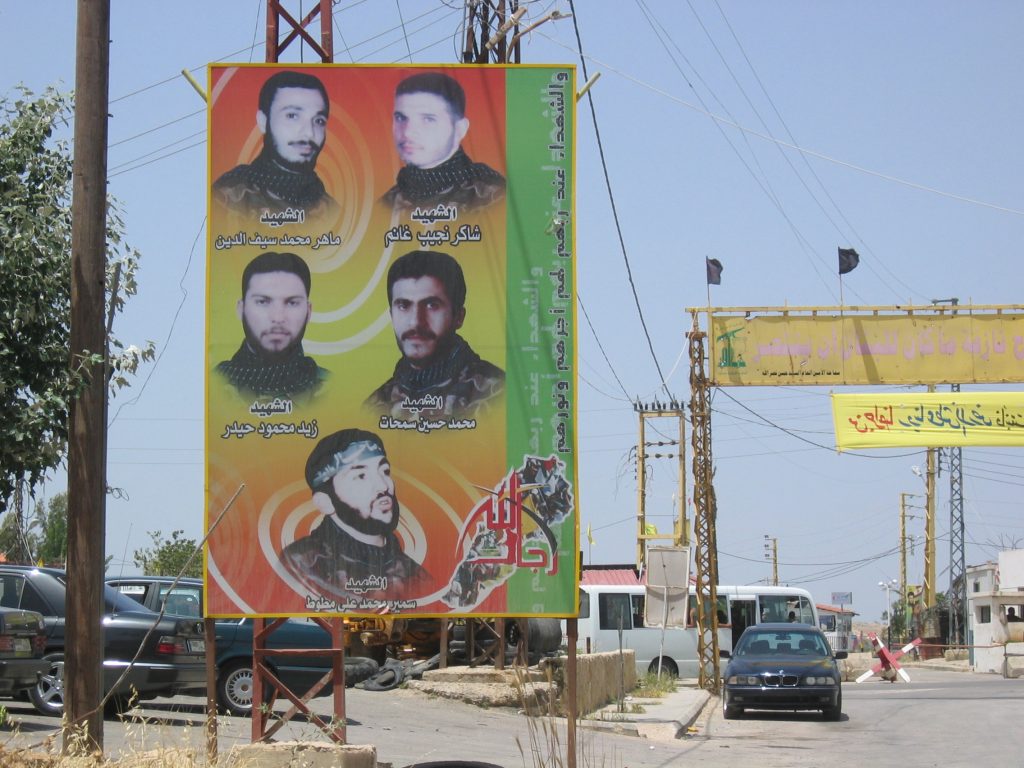
Money from Iran and Qatar has gone directly into the reconstruction of roads, bridges and villages, bypassing the Lebanese government, who would have made the reconstruction process a lot slower, and probably also wasted or ‘lost’ some of the funds. Hezbollah, of course, was first on the scene, giving US\$10,000 to each family or person whose home was damaged within a month of the war’s end. With this amount, they could rent temporary accommodation while their home was rebuilt.
The view along the road from Tibnin over the valley and mountains towards Bint Jbeil, Aitaaroun, Maroun al Ras and Yaroun is unexpectedly beautiful and serene. The green and ochre fields are neatly ploughed and the terraced mountainsides timelessly ordered. Less than two years on, the reconstruction of the border villages that were devastated by Israeli bombs is not only in full swing but also far advanced. Having seen the shocking destruction in some areas two months after the war, I found the remarkable progress to be a welcome sight. Qatar took on the reconstruction of four of the villages that were hardest hit – Bint Jbeil, Ainata, Aita el Chaab and Khiam – while Iran financially supported Hezbollah and also directly hired Lebanese engineering companies to do the work.
It was business as usual in Bint Jbeil, with the busy weekly market attracting farmers and shoppers from the wider area. This is the town where Hezbollah leader Sheikh Hassan Nasrallah gave his famous victory speech in May 2000, when Israel withdrew from its twenty-two-year occupation of the south. In the 2006 war, Hezbollah fighters prevented the Israeli tanks and infantry from entering the town centre and held them off at its edges, but relentless bombing destroyed everything anyway. Many civilians were trapped in basements for up to twenty days before there was a forty-eight hour break in the onslaught. I talked to an elderly lady, Mrs Beydoun, whose late husband had built the Imam al Ali mosque. She still looks after it and lives in an apartment upstairs. For fifteen days and nights of continual bombing, 150 residents of Bint Jbeil, all women, children and old people, lived in the cellar under the mosque. Unlike others who were sheltering in basements, they managed to get some food when a nearby grocery store was bombed: a few individuals snuck out to bring back what they could. Eventually they risked the frightening journey north under the bombs. Mrs Beydoun’s flat upstairs and much of the mosque were destroyed, but the Qataris had it all fixed up within nine months. ‘What would you do if it happened again?’ I asked. ‘God willing it won’t. Something like that can’t be taken more than once in a lifetime’.
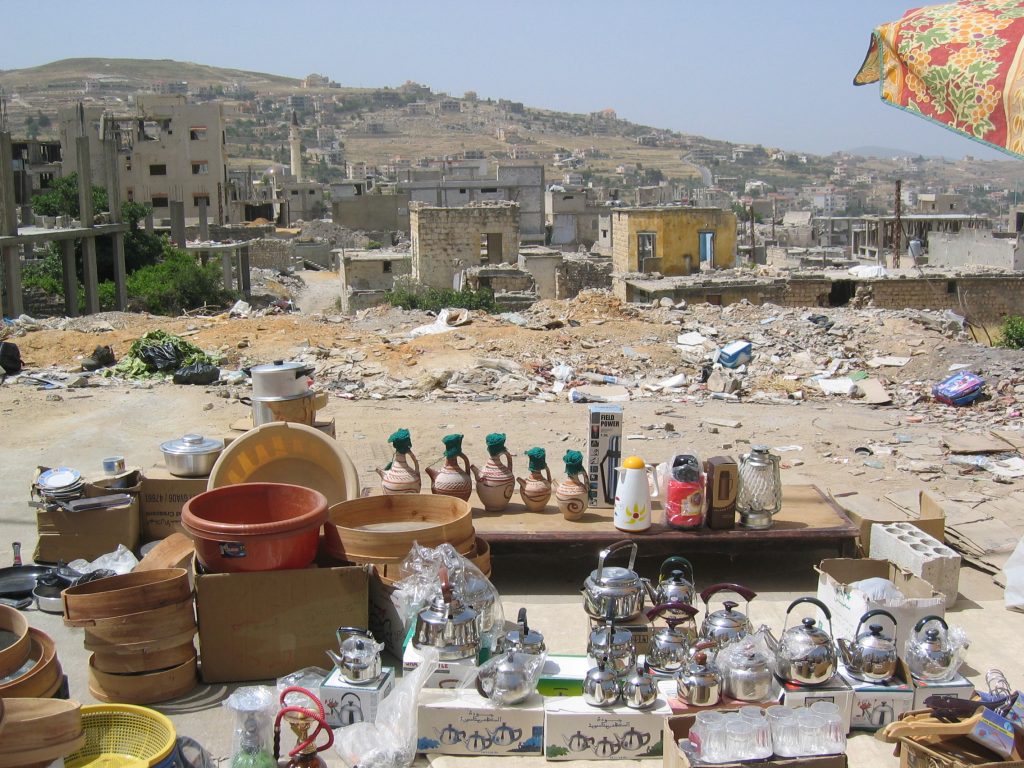
In the neighbouring village of Ainata , we dropped by to see Samira Khanafer. She is the cousin of my driver, Mohamed, and we had coffee and fig rolls while her teenage daughters watched a lurid Turkish soap dubbed into Arabic on TV. I asked about her family’s experience. They heard the bombs in nearby Aita el Chaab first, and then small bombs fell on Ainata for five days. They turned into large bombs on the sixth day, so on the eighth she left with her husband, four children and parents. The planes were above them on their journey north, a car full of civilians in front of them was hit, but they continued, making a large detour around the bombed UN station in Tyre . They ended up in Bhamdoun in the mountains, where the extended family met up and rented a flat at \$2000 a month for the remainder of the war.
Samira and her family had left everything and everything was turned to rubble but, like most people, they returned as soon as the war ended. The Lebanese Army, the Qataris and the UN swept some of the region for unexploded munitions and cluster bombs, but an estimated million remain unfound, and Israel still refuses to tell the UN where they were dropped. About 100 million dollars of farm crops have been lost because of these, forty people have been killed and over 250 injured. Samira’s aunt bent down to pick up what she thought was a lettuce leaf in her garden but a cluster bomb removed her fingers and exploded in her face and chest. She died a month later.
I asked Samira whether, having gone through the war, she could rebuild again if there were another. ‘Of course’, she said. ‘We’re used to it.’ Mohamed joins in at this point: ‘ Israel has been coming here for forty years, we’re used to rebuilding. We’re from here, this is our home. Of course we’ll rebuild.’
‘And what about the dead? Over a thousand, mostly civilians?’ I asked.
‘Life goes on. We’re born here, we live here, we return here,’ Mohamed continued.
Mohamed, who is not affiliated with Hezbollah at all, had nevertheless explained to me on the journey down that Hezbollah is the people, and the south is the home of the people. The occupation had already emptied much of the area of its residents: men and teenage boys left to avoid being recruited by the Israelis into the South Lebanese Army. Since the end of the occupation, men have been leaving their villages to find work, but they often return. Many families who travel to America and Africa , the most common destinations for the Shi’a of the south, return to their villages to build large villas with the money they made abroad and make sure their children remain Lebanese.
On the way out of Ainata, we pass one of these enormous villas. The owner, Mohamed’s distant relative, had made his fortune in America and brought back with him a piece of his adopted country. Mohamed waved a twenty-dollar bill in my face: ‘See, it’s this house’. It was indeed the White House itself, rebuilt in the southern Lebanese village that had been bombed by Israel with American support.
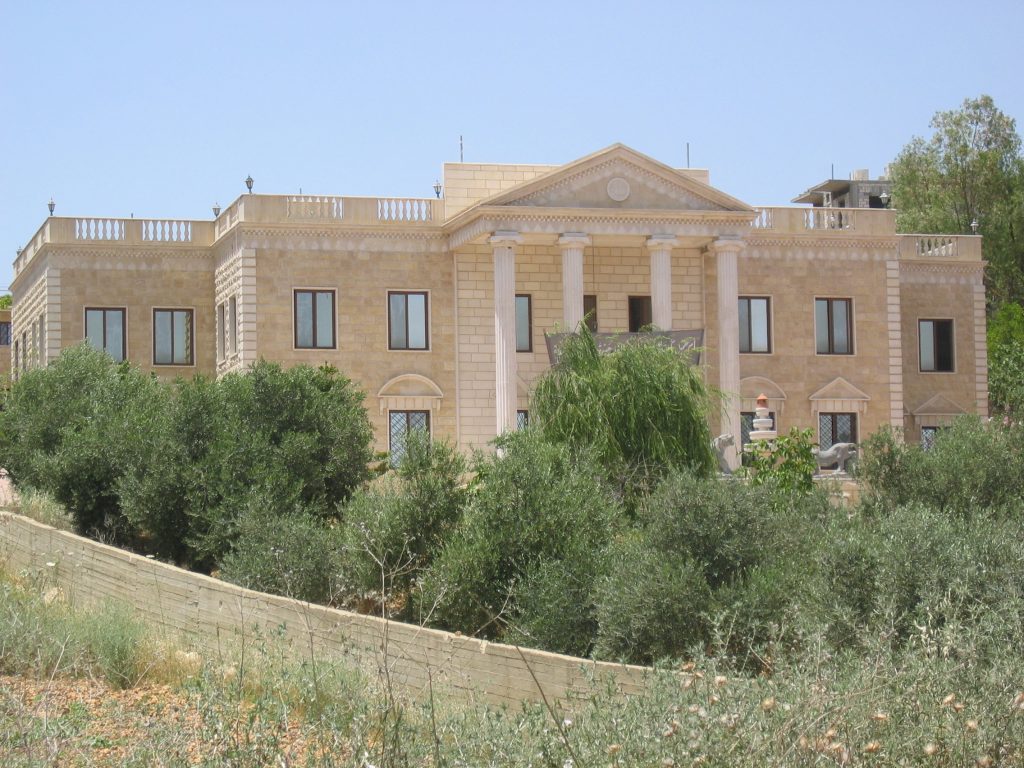
The journey continued along a far bumpier road. We made a detour to the mixed Christian and Muslim village of Yaroun , and returned to pass through the Christian village of Ain Ibel , along the lush tobacco fields around Rmeich, and on to Aita el Chaab, the village closest to the southern border. The reconstruction is not far advanced here, and the road is still damaged by potholes caused by bombs. We drove slowly to avoid destroying the creaking car. Jolting and zigzagging along, we were also more or less following the length of the Israeli border, and at some point a surreal dirt road emerged, apparently from nowhere, heading in our direction. It was the road the Israelis built straight through the border to drive their tanks into Lebanon .
We passed a group of men in blue uniforms, UN guys from Fiji , resting under the makeshift shelter of a half-destroyed house. We acknowledged them with a wave and soon realized we had missed the turning to Aita el Chaab. We returned along the uncomfortable road, nodding at the Fijians again, and finally arrived, to be greeted by a poster of Amal leader Nabih Berri with local martyr Mohamed Srour. We stopped at the first grocery store and I ran in to buy some Coke. I asked the young man behind the counter to point out which parts of the village were most destroyed during the war, then asked him whether he was happy with the reconstruction.
He was. His family has had two instalments of money from Qatar , at intervals of three or six months. The third and final instalment will be handed over shortly, after they show the photographs of the progress on their house. Hezbollah gave them the standard \$10,000 dollars and a further \$6,000 gift for the grocery shop.
I asked him where he went during the bombing.
‘I stayed here’.
‘Here?’
‘Yes,’ he said, with a gesture that meant ‘that’s all I have to say’.
‘You mean you were a fighter?’
Ali lowered his eyes modestly and I looked at him carefully. He was tall, good-looking, clean-cut, and exuded a quiet confidence: south Lebanon’s finest. I pressed him to tell me what happened.
The women, children and older residents fled to one of the nearby Christian towns and he remained to defend the village with several other fighters, locals backed by Hezbollah. The bombing only let up during three serious attempts to take over the whole village. I had already heard that the month-long resistance in Aita al Chaab had become a local legend. In one of the skirmishes, Ali explained, they ambushed an Israeli armoured tank entering the village to flatten houses and chase out the fighters.
‘The tank remained in Lebanon ’, he concluded, as if it were a prize. It may well have ended up in Hezbollah’s ‘House of the Spider’ exhibition, which commemorated the first anniversary of the war last year and displayed captured IDF weapons and personal objects, such as a soldier’s iPod.
Would you stay and fight again?’ I asked Ali.
‘Yes. And again and again. If it happens again no one will leave. We’re stronger now’.
‘Was it worth it? With over a thousand killed, mostly civilians?’
‘This is my home. We’ll stay. My brother too – ’ he said, gesturing to a teenage boy entering the shop, ‘he’ll stay’. His brother smiled shyly, but proudly.
On the road back through Naqoura and northwards along the banana fields, I think about Mohamed’s words. Hezbollah is the people, and the south is their home.
In Beirut , the question of Hezbollah’s status as a resistance group continues to be questioned and debated. Hezbollah is now entering a more political phase, but it is not handing over its weapons and is in fact building up its own independent communication network. And if the west does not allow the Lebanese Army to become a strong and viable defence force, one argument goes, someone has to defend the country in case of another attack.
Until such issues are settled, Lebanon remains in a precarious situation. There is a president at last, but the country still hasn’t managed to put together a cabinet. The different parties wrangle over the more interesting seats, hoping to be in a stronger position when the 2009 elections come around. If the cabinet is not formed, the head of the Lebanese Army cannot be appointed, and the internal security situation also remains unstable. The Army plays a sensitive role and does not like to interfere in sectarian fighting, since its recruits come from all sects; the recent Sunni-Shi’a clashes in Tripoli and the Beqaa valley therefore continue mostly uncontrolled. Without a cabinet, necessary economic, social and political reforms cannot be implemented, the day to day running of the country is on hold, and there remains little investor confidence.
The recent visits of Nicolas Sarkozy and Condoleeza Rice indicate a return to some sort of normality for now, but they passed by with little comment or fanfare. I did notice, though, that for the short duration of each of the state visits, certain billboards along the highway from the airport into Beirut were removed and replaced by Lebanese and French flags. These depicted Hezbollah leaders, and one poster, referring to the bombing of Qana, showed Condi baring her fangs, sucking the blood of a baby. American foreign policy is perceived as murderous by Hezbollah and the people of the south who were most affected by it. In fact, all Lebanese see the west’s support for or reluctance to stop the bombing in 2006 as unjust and inhuman. However, the war further polarized the country between government and opposition, increasing support for Hezbollah among those who were hardest hit by the bombing. With the May clashes, Hezbollah flexed its muscles, and the Doha agreement marks its substantial entry into mainstream politics. The question of whether Hezbollah can continue to call itself a ‘resistance’ has become even more pressing.
Read the full article here
